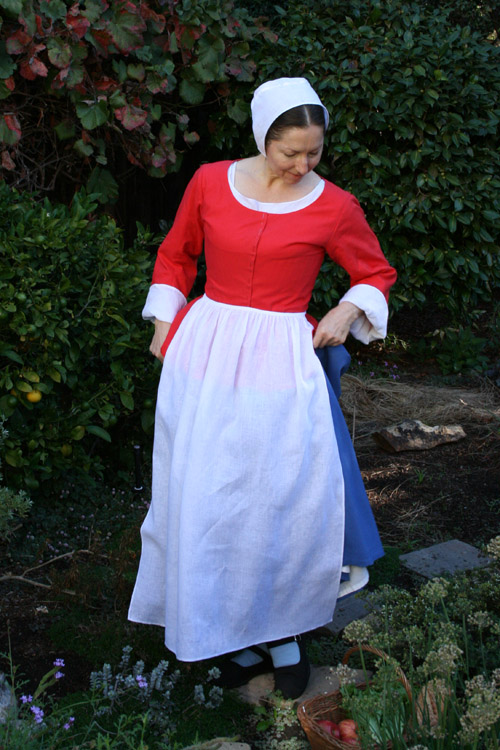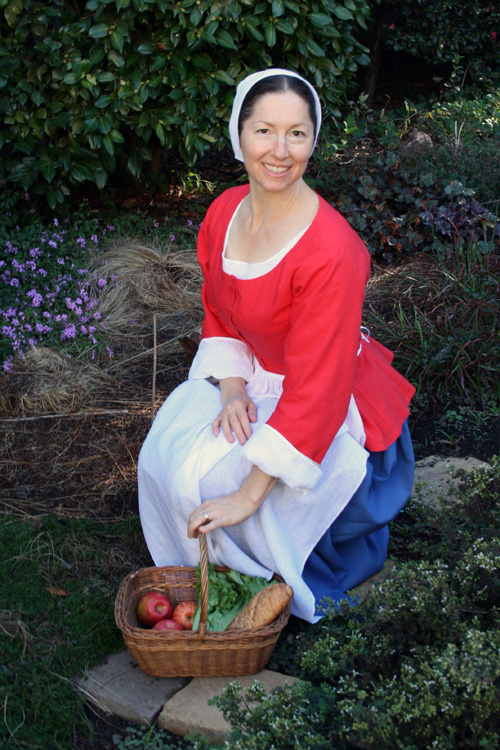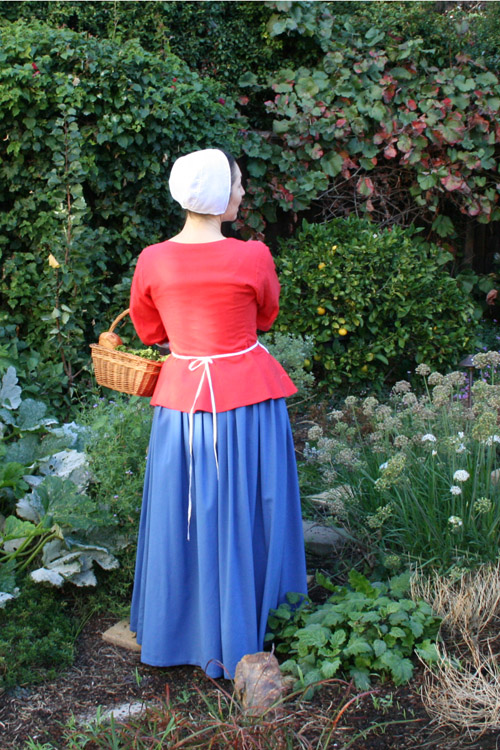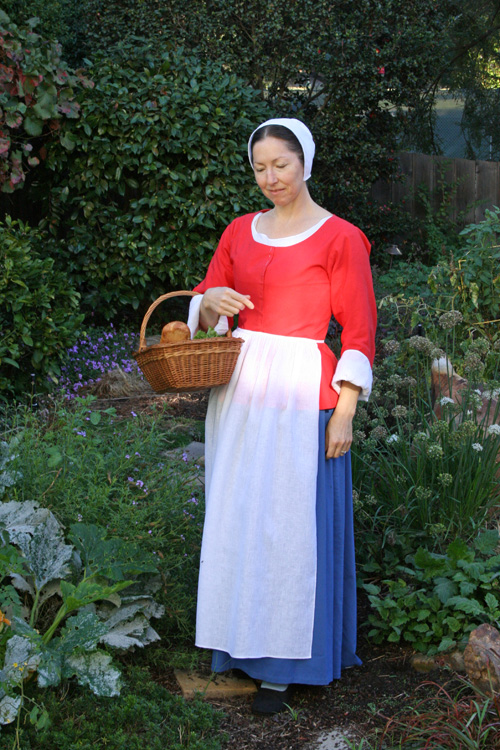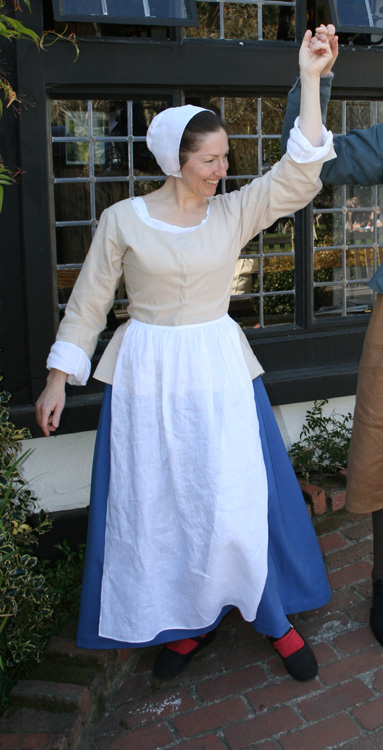
July 2012 – April 2013
This is the counterpart to Aaron’s 1660s Peasant wear. It’s inspired by the “peasants dancing at taverns” scenes in genre paintings of the mid-17th Century. Teniers’ works are some of my favorites. Country Kermess is a good example. The costume consists of smock, stays, petticoat, two interchangeable jackets, apron, and cap. In order to keep the skirt drape fairly close to the body I’m not wearing an under-petticoat. But I did add a little shape with my Victorian bum pad.

Rijksmuseum, Amsterdam
Jackets
The jacket’s body is from The Tudor Tailor. I scaled up the pattern by hand, then gave it a 3″ grade. (It was nice to practice the skill again, if very briefly. I like to be able to justify that year of grading class). Happily at that point, the pattern was a pretty good fit. The jacket was then lengthened and the gores were made wider, per the examples in 17th Century Women’s Dress Patterns. The sleeves are my own draft – full enough to do a peasant dance. They’re 3/4 length, two piece curved sleeves, with cuffs based on Hunnisett’s 1645-55 sleeve. The smock rolls up over the cuffs, so they don’t actually show. The jacket’s neckline is cut down, but more conservatively than Teniers’ peasants. It’s closer to Vermeer’s The Milkmaid.


Rijksmuseum, Amsterdam

Both jackets are unlined. The jacket seams are sewn by machine. The gores were felled by hand and the cuffs were handsewn to the sleeves. The jacket’s neckline and center front edges were turned in and faced with bias tape. The tape was sewn by hand with fell stitches. These edges are also stabilized with lining selvages. So, while the jacket has a period look along the outside edge, my fell stitches hold down 1/2″ bias tape, rather than 1/2″ twill tape.
For the red jacket, I tried finishing the edges with 1/2″ cotton tape (illustrated in 17th Century Women’s Dress Patterns). With a lot of steam and stretching, the tape did lay flat and neat along the curves. But the extra bulk from the tape bothered me. More importantly, I found that the tape removed so much ease that the jacket became restrictive. Though an interesting experiment, I decided to ditch the awkward period materials and went back to the method used on the oatmeal version.
The jackets are both linen-cotton blends. Cuff turn-backs are lined in an oatmeal colored fine linen. I am now officially a linen-cotton blend convert. This fabric holds up it’s appearance so much better than wrinkly 100% linen. Aaron’s costume was wrinkled before he even got in the car. I think this will be used it in lieu of linen for future jackets, doublets and vests.
The oatmeal jacket fastens up the front with hooks. I still ended up using a few pins to keep everything flat and secure. The red version simply pins shut.
Petticoat
I picked up this bright blue wool for the petticoat from William Booth Draper. The pattern is slightly gored, per The Tudor Tailor‘s basic petticoat. I felt this cut would better match the dancing peasants than a full rectangle. It has a 100″ hem circumference. The petticoat has a flat front, knife pleats at the side fronts, and cartridge pleating continuing to the back. The petticoat opens at center front with a slit. I was intrigued by the skirt is this de Hooch and wanted to give it a try. This opening would show were it not for the apron.

Pieter de Hooch, 1659: detail from Mother Lacing her Bodice Beside a Cradle
Gemaldegalerie, Berlin

Private Collection

I doubt my petticoat looks particularly peasanty or period on the inside. It’s fully lined in cotton batiste – my favorite choice for a wool like this. Both skirt and lining hems are handsewn separately and the lining hangs free. (Incidentally, the “dancing” photo show a wider, temporary hem. The length was fine, but I wanted to wear it once to be sure). At the waist, the lining and wool are sewn together, pleated, then whipped to a finished waistband, just like the gold 1860s skirt. The skirt and lining slits are hemmed separately, and the lining is felled to the skirt for the first couple of inches.
The petticoat in the Teniers above, is a nice peasanty example. It’s very different from my own: the waistband seems to be bound and it has a side-opening. There are many rows of mysterious, shiny trim at the hem. And there’s almost no gathering at the waist. As this skirt would require very little fabric, I felt confident that a gored skirt and 100″ hem was reasonable.
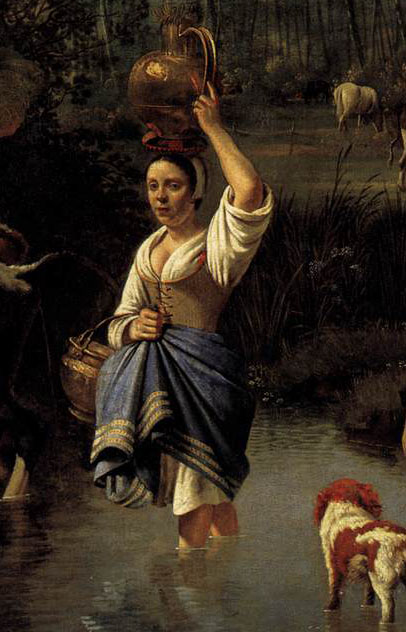
Staatliche Museen zu Berlin, Gemäldegalerie, Berlin, Germany

Private Collection
Stays
Then, there is the seemingly never-ending-need for new stays.
There’s a lot of variation in silhouette within the working classes: everything from a shelf-like bust, to a natural figure. I suspect that the look I was aiming for – fairly round – was achieved with either boned stays like in Jan Siberechts’ painting above, or a similarly low-cut boned bodice. Before finalizing the fit on my jacket I spent a good bit of time experimenting with period and modern foundation garments out of my closet. Then resigned myself to the fact that I would need to throw together new stays: the Renaissance peasant stays. To keep everything smooth under the jacket, I also wear a sports bra. It may be an historical faux pas, but I can live with it. At any rate, it’s as good as I’m going to get for now. I should point out that the top line of my stays is visible under the jacket — I don’t fret over this. I imagine that’s what’s going on in Pieter de Hooch’s Figures Drinking in a Courtyard.
Accessories
The linen apron and Dutch cap also have pages of their own. I plan to experiment with a few more mix and match pieces to wear with the ensemble. It’s really quite comfy, as far as costumes go.
